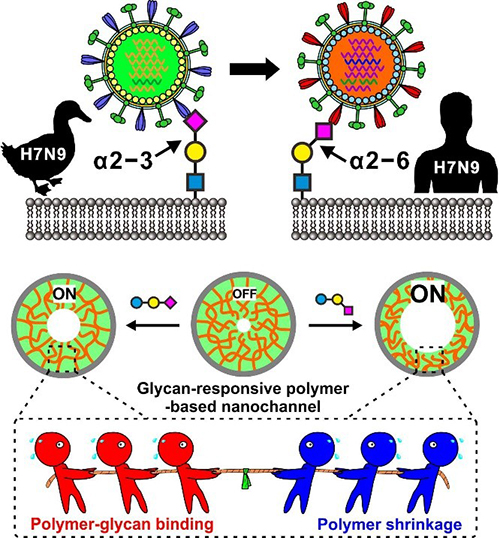A research group led by Prof. QING Guangyan from the Dalian Institute of Chemical Physics (DICP) of the Chinese Academy of Sciences (CAS) recently constructed a bioinspired nanochannel device and realized the precise recognition and discrimination of sialylated glycan linkage isomers. This work was published in Chemical Science.

Design of the biomimetic nanochannels for glycan recognition. (A) H7N9 virus binds to avian a2–3-linked sialylated glycan receptor, while the reassortant H7N9 virus binds to human a2–6-linked glycan receptor. (B) Schematic illustration of glycan-induced nanochannel“OFF–ON”changes and
the tug-of-war cartoon to illustrate the competition between polymer-glycan binding and the polymer shrinkage. (Image by LI Minmin)
Sialylated glycans that are attached to cell surface mediate diverse cellular processes such as immune responses, pathogen binding, and cancer progression. Precise determination of sialylated glycans, particularly their linkage isomers that can trigger distinct biological events and are indicative of different cancer types, remains a challenge, due to their complicated composition and limited structural differences.
In this work, QING and co-workers creatively introduced the bioinspired nanochannel as its sensitive perturbation of ion flux to the recognition of glycans with subtitle difference in structure. They report a glycan-responsive polymer-modified nanochannels device, which demonstrates the capacity of recognizing and discriminating sialic acid form other neutral monosaccharides, different sialic acids, and even sialylated glycans with α2-3 and α2-6 linkage.
In-depth studies revealed a competition between the polymer shrinkage caused by electrostatic attraction and shrinkage-resistance from the strong binding of the polymer with glycan molecules, which contributed to the varying extend of shrinkage of the graft polymer in nanochannels, and the different “OFF-ON” change in ion flux and the detectable current signals.
This work broadens the application of nanochannel systems in bioanalysis and biosensing, and opens a new route to glycan analysis, for example, the single-molecule analysis of complex glycan using single nanochannel/nanopore, that could help to uncover the mysterious and wonderful glycoworld.
According to the similar strategy, the group also designed and developed the Ca2+-self-controlled bioinspired Ca2+ nanochannels (NPG Asia Materials, 2019) and the cyclic adenosine monophosphate (cAMP)-controlled ion nanochannels (J. Mater. B., 2019). These works further highlight the potential of biomolecule-responsive polymer for the construction of bioinspired ion nanochannels.
These works were supported by the National Natural Science Foundation of China, DICP Innovation Funding, and LiaoNing Revitalization Talents Program. It was dedicated to the 70th anniversary of DICP, CAS. (Text by LI Minmin Li, QING Guangyan)